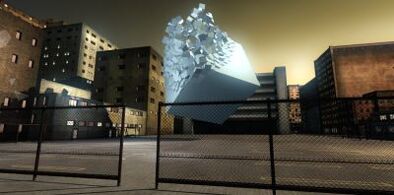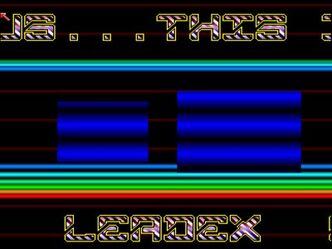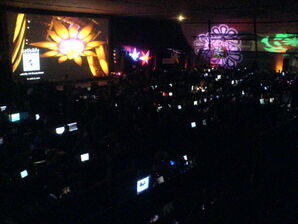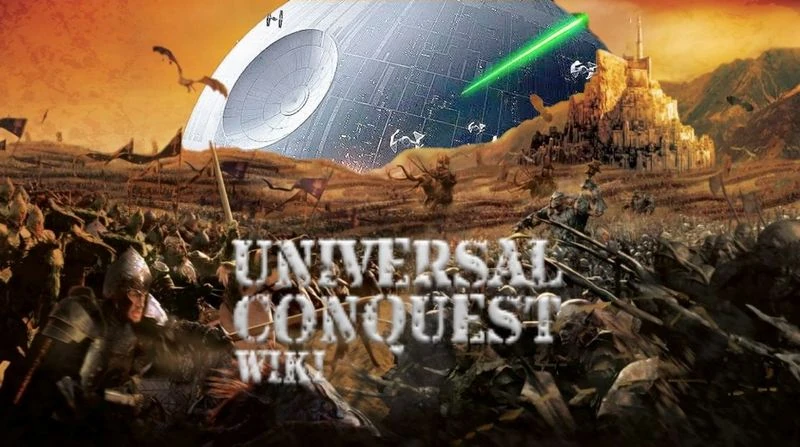
a demo, fr-041: debris by farbrausch
The demoscene is the technical and creative work of demosceners, demoparties and demo-culture. The aim of the demoscene is to showcase the technical and artistic work of demosceners, sometimes called sceners, through software (prods), music and artwork. A demoscener is an individual who contributes to the demoscene. Demosceners sometimes form groups, or demogroups, in order to collaborate with one another in producing work. A typical showcase of this work is called a demo. A demo is a non-interactive realtime program that displays visuals, sound and music. Creating and watching demos can be very fun because they often do things that were previously thought to be impossible on the hardware platforms on which they run. The technical and artistic achievements of the demoscene are many. Examples of this include realtime 3d texture-mapped graphics on the Commodore 64 (a computer that can't natively divide two numbers), realtime raytracing, raymarching, faster then 30 fps 3d graphics with bump-mapped textures and per-pixel lighting on 486 class hardware and full-length feature-rich entirely procedurally generated demos in 4 kilobytes of code to name just a few. The demoscene is usually the first pioneer of new graphics techniques and improves existing algorithms and techniques to levels of efficiency previously thought impossible. Driving forces behind the demoscene include community, breaking limits, having fun and generally doing cool things.

Wings of Hury cracktro by leadex, cracked 1990
The demoscene comes from the software cracking and piracy scene. Before there was a demoscene there was a cracking scene. Cracking is the removing, bypassing or modifying, of anti-piracy mechanisms of commercial software. Crackers and cracking groups very rarely sell their work and doing so is usually frowned down upon in the cracking scene. When cracking groups release new cracks they usually include a short introduction that displays when the cracked program is run. This introduction is called an intro. Intros typically show which cracking group did the work, show off technical and artistic skills, and give shouts (sometimes called greetz) or fuckings (disparaging comments) to other cracking groups. In intros shouts praise the work of others while fuckings dismiss it. Crackers and cracking groups would sometimes organize into copy-parties or other gatherings in order to show-off their work to one another. As cracking groups grew in size they would usually divide work up into different internal departments. In a typical cracking group there would be departments for the intro creators, software crackers, distributors (usually over BBSes), telecom and public relations. In an intro technical work is showcased, typically, in effects. For example, one effect is scrolling sinusoidal-moving text, known as a scroller, that displays information about the cracking group. Eventually the skills of the intro department would grow so much that it began to splinter from the rest of the cracking group. Eventually parties were formed to showcase the work and achievements of the intro creators alone. As popularity grew the intro creators divorced themselves entirely or partially from the rest of the cracking groups and formed their own parties. The term cracktro was applied to intros meant for cracked software and intro was retained for producing intros for their own sake. Intros grew in duration and complexity and as more and more effects were strung together in sequence they became known as demos. The parties to showcase then were named demoparties.

breakpoint '08 demoparty
Demoparties serve as social events to get demosceners together to socialize and show off their technical and artistic skills to one another. Organizers of demoparties are usually referred to as orgas. Showcases of work usually occur in competitions, called compos, wherein winners are established by peers' votes. The winners of compos are usually given prizes like homemade trophies, cookies, computer equipment and even money- among other things. Votes are sometimes taken and tabulated by, usually demoscener created, software called votedisk. Compos are usually organized into different categories by hardware-platform and type. Types of compos include: 4k, 64k, procedural graphics, executablemusic, demo, fastdemo, music, fastmusic and wild, to name just a few. News of demoparties and their winners are usually distributed by demoscener created software called a report, which usually occurs after the party or near its end.
The demoscene has developed its own unique lexicon. Some examples of this include:
- prods (software) terms
- bbstro
- cracktro
- demo
- demopack
- demotool
- dentro
- livetro
- diskmag
- fastdemo
- intro
- invite
- musicdisk
- procedural graphics
- report
- demoparty terms
- orga
- sleeping hall
- mystery zone
- party version
- partyplace
- terms related to art
- gfxr
- graphician
- dutch color scheme
- coderscolors
- crackart
- terms related to code
- lamer
- fartcoder
- sizecode
- speedcode
- drivecoding
- partycode
- rasterbars
- copperbars
- coppershade
- hypnoglow
- scroller
- plasma
- glenz vectors
- vector balls
- bump glow
- sinusbobs
- pixeller
- pixelpusher
- overscan
- sidebars
- rotozoom
- sounder
- terms related to music
- tracker
- tracker junkie
- bassters
- doskpop
- trackmo
- chiptune
- compotune
- runtime tune
- codermusic
- boobietracker
Examples of women in the demoscene in no particular order who are already out as women (see outing) with their group affiliations:
- clary or clarie of Drifters and Nova
- Acid Girl of Nature Born Hackers
- Lluvia of Bomb and TPOLM
- glittermouse
- agonia of Concern Chaos
- leia of Apathy, Squirrelz, cellfish, scene.org awards orga and assembly orga
- faith
- drumu
- delilah
- aracia of Scoopex
- sardu
- SigFLUP of Sickest Ravers on The Planet Earth
- sole of xplsv
- Amy Pandagirl of Knuckle Girls
- alv of Squirrelz
- ayame
- elmindreda of hypercube
- Jeri Ellsworth
- akasha of antichok
- rasputina
- zania
- Anna of Chemical Sisters
- nogsf of Kamelite and Level-D
- beetas
- case of Faith Lightforce whelpz
- Christine de la Queen of Spoon
- Alice of Mad Elks
- Almeria
- alv of Squirrelz
- amanda of Capella
- amnesia
- Andrea
- Ernie of anubis
- fashion of smash designs
- Helen Shields of Varsity
- aru
- Athena of Diffusion
- Ava of Jumalauta
- D'arcy of Excess
- Deb of Battery
- dosifei
- E-liza of nuance
- delora of whelpz
- Dj Pudding
- EmmaIV of Sorrox
- Kisu
- Kitana of TDR and Tide
- Lea of Popsy Team
- Lena
- Erena Kline of Proxima Centauri
- Hirojuki of HJT
- honeybunny of mfx
- icegirl of Role
- Indhra
- Kayleigh of Fatum
- Kiliana
- Liz of Spinning Kids
- Luna
- mad of Overlanders
- Malon
- MandyBee
- Manka of Autopsy
- Margareth of Fatum
- Marianne
- Myhrer
- mav of Equinox
- Mermaid of Crest, Creators, Scoopex, Bandwagon, retrocoders and Resistance
- Milie of CIA
- Miss Saigon
- Mona Lisah of Trax In Space
- Monica of Funzine
- Monique of Stella
- Mrs Black
- Mrs Freeze
- Nici of TDD
- Nina of asd
- snappy of Aion
- Sofia
- special_k of 3
- squirrel of Anarchy
- starlight of Extacy and Therapy
- patsy of brainstorm
- peaky of Squirrelz
- Pennie of bronx and phaze 101
- Tanja of Effect and abyss connection
- tassle of Endzeit
- TBB of Genetix, Entropy, Side B, Alcoholics, Exotic Designs, tat
- The Left of Diamond Group
- The Mistress of Angry
- popi of The Black Cats
- puddy of Level-D
- Rocio
- Sabine of Alphaflight
- Sara of Balance
- shortie of Sonic Dreams
- Silverstar of anubis
- Simone of Shelters and Kreciki
- sister of Antares
- Skie
- SMD
- storm of Maniacs
- suicide of TDD
- witch of Lethargy
- zeugma of Melting Pot and TWB
- sunny of nuance
- The Sorceress of Genesis Project
- trussi of Kiki Productions
- vampire of DAI
- venusia
- windsurf
- wiquie of Cytax

